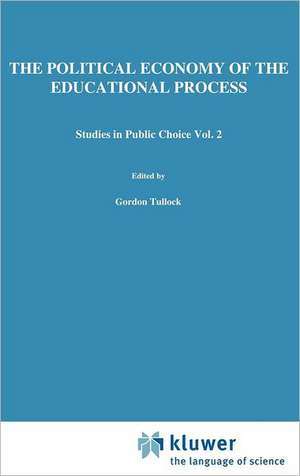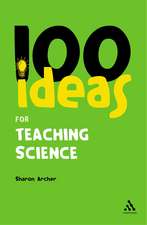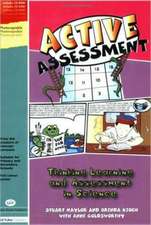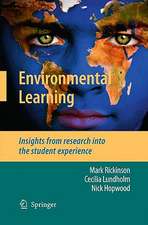The political economy of the educational process: Studies in Public Choice, cartea 2
Autor R.B. McKenzieen Limba Engleză Hardback – 30 iun 1979
| Toate formatele și edițiile | Preț | Express |
|---|---|---|
| Paperback (1) | 777.18 lei 38-44 zile | |
| SPRINGER NETHERLANDS – 13 oct 2011 | 777.18 lei 38-44 zile | |
| Hardback (1) | 947.50 lei 6-8 săpt. | |
| SPRINGER NETHERLANDS – 30 iun 1979 | 947.50 lei 6-8 săpt. |
Din seria Studies in Public Choice
-
 Preț: 542.84 lei
Preț: 542.84 lei - 18%
 Preț: 958.38 lei
Preț: 958.38 lei - 20%
 Preț: 579.92 lei
Preț: 579.92 lei - 18%
 Preț: 780.82 lei
Preț: 780.82 lei -
 Preț: 395.09 lei
Preț: 395.09 lei - 5%
 Preț: 370.58 lei
Preț: 370.58 lei -
 Preț: 381.81 lei
Preț: 381.81 lei - 18%
 Preț: 1228.77 lei
Preț: 1228.77 lei - 15%
 Preț: 637.46 lei
Preț: 637.46 lei - 18%
 Preț: 942.63 lei
Preț: 942.63 lei - 15%
 Preț: 640.71 lei
Preț: 640.71 lei - 15%
 Preț: 633.53 lei
Preț: 633.53 lei - 18%
 Preț: 945.62 lei
Preț: 945.62 lei - 20%
 Preț: 560.55 lei
Preț: 560.55 lei - 15%
 Preț: 632.37 lei
Preț: 632.37 lei - 15%
 Preț: 635.15 lei
Preț: 635.15 lei - 15%
 Preț: 634.49 lei
Preț: 634.49 lei - 15%
 Preț: 635.01 lei
Preț: 635.01 lei - 15%
 Preț: 638.89 lei
Preț: 638.89 lei -
 Preț: 381.81 lei
Preț: 381.81 lei - 15%
 Preț: 640.88 lei
Preț: 640.88 lei -
 Preț: 385.62 lei
Preț: 385.62 lei -
 Preț: 393.13 lei
Preț: 393.13 lei - 15%
 Preț: 697.00 lei
Preț: 697.00 lei - 15%
 Preț: 586.70 lei
Preț: 586.70 lei -
 Preț: 389.31 lei
Preț: 389.31 lei - 15%
 Preț: 643.84 lei
Preț: 643.84 lei - 18%
 Preț: 727.00 lei
Preț: 727.00 lei
Preț: 947.50 lei
Preț vechi: 1155.48 lei
-18% Nou
Puncte Express: 1421
Preț estimativ în valută:
181.32€ • 196.89$ • 152.31£
181.32€ • 196.89$ • 152.31£
Carte tipărită la comandă
Livrare economică 22 aprilie-06 mai
Preluare comenzi: 021 569.72.76
Specificații
ISBN-13: 9780898380125
ISBN-10: 089838012X
Pagini: 216
Ilustrații: 216 p.
Dimensiuni: 155 x 235 x 18 mm
Greutate: 0.5 kg
Ediția:1979
Editura: SPRINGER NETHERLANDS
Colecția Springer
Seria Studies in Public Choice
Locul publicării:Dordrecht, Netherlands
ISBN-10: 089838012X
Pagini: 216
Ilustrații: 216 p.
Dimensiuni: 155 x 235 x 18 mm
Greutate: 0.5 kg
Ediția:1979
Editura: SPRINGER NETHERLANDS
Colecția Springer
Seria Studies in Public Choice
Locul publicării:Dordrecht, Netherlands
Public țintă
ResearchCuprins
1. An introduction to economics and the economics of education.- 1.1. Theory: a matter of necessity.- 1.2. The basics of economic theory.- 1.3. A final preliminary note.- 2. The basics of the economic model.- 2.1. An introductory statement.- 2.2. A more complex statement: the student’s opportunity set.- 2.3. The student’s preference structure.- 2.4. The logic of student choice.- 2.5. Concluding comments.- 3. Student preferences, abilities, and performance.- 3.1. Student preferences 3.- 3.2. Student abilities.- 3.2.1. Different levels of initial achievement.- 3.2.2. Different aptitudes.- 3.3. Efficiency gains and the evaluation of the professor.- 4. Professor preferences, public goods, and student performance.- 4.1. Faculty choice and student achievement.- 4.2. Student quality and faculty effort.- 4.2.1. Different initial achievement levels.- 4.2.2. Different aptitudes.- 4.2.3. Different initial endowments and aptitudes.- 4.3. Classroom technology, teacher ability, and faculty effort.- 4.4. Teaching as a public good.- 4.5. Concluding comments.- 5. Is teaching the best way to learn?.- 5.1. The effects of student proctoring.- 5.2. The illusion of cost-benefit analysis.- 5.3. Optimum learning.- 5.4. Student aptitude once again.- 5.5. The institutional setting and educational change.- 6. The effects of grade inflation on student evaluation and performance.- 6.1. The model.- 6.2. Grade influation.- 6.3. Real grade influation.- 6.4. Empirical tests.- 6.5. Concluding comments.- 7. The evaluation and pay of faculty.- 7.1. Research findings: the effects of research and teaching on faculty pay.- 7.1.1. The Katz study.- 7.1.2. The Koch-Chizmar study.- 7.1.3. The Tuckman-Chapinski-Hagemann study.- 7.1.4. The Siegfried-White study.- 7.1.5. Interim summary of conclusion.- 7.2.Research findings: the influence of research on teaching effectiveness.- 7.3. The evaluation of faculty: the interactive effects of student and faculty efforts and academic freedoms.- 7.4. The pay system.- 7.4.1. The lump-sum pay method.- 7.4.2. Accountability.- 7.5. Concluding comments.- 8. Committees, “Comment Pollutions,” and the internal governance of universities.- 8.1 Comments as public goods.- 8.2. The judgement of committeemen.- 8.3. Concluding comments.- 9. The citizenship argument for education.- 9.1. Citizenship, public goods, and economics.- 9.2. Public choice view.- 9.3. Counterarguments.- 9.4. Course content for rational students.- 9.5. Concluding comments.- 10. The academic market, intercollegiate sports, and academic standards.- 10.1. A supply and demand model of the education market.- 10.2. The impact of intercollegiate sports.- 10.3. Concluding comments.- 11. Cheating and chiseling.- 11.1. The prevalence of cheating.- 11.2. The effects of cheating.- 11.3. The rationality of cheating.- 11.4. Chiseling.- 12. Postscript.












